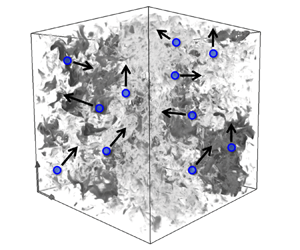Article contents
Fluid inertia effects on the motion of small spherical bubbles or solid spheres in turbulent flows
Published online by Cambridge University Press: 25 June 2021
Abstract

In this paper we study finite particle Reynolds number effects up to  $Re_p=50$ on the dynamics of small spherical bubbles and solid particles in an isotropic turbulent flow. We consider direct numerical simulations of light pointwise particles with various expressions of the drag force to account for finite
$Re_p=50$ on the dynamics of small spherical bubbles and solid particles in an isotropic turbulent flow. We consider direct numerical simulations of light pointwise particles with various expressions of the drag force to account for finite  $Re_p$ and the type of particle. Namely, we consider the Stokes drag law, the Schiller and Neumann relation and the Mei law. We show that an effective Stokes number, based on the mean value of the drag coefficient to account for the inertial effects involved in the drag law, gives a quasi-self-similar evolution of the variances of the bubble acceleration and of the forces exerted on the particle. This allows us to provide a satisfactory prediction of these quantities using Tchen's theory at finite particle Reynolds number. Based on these relations, we can specify the conditions under which the total inertial force (sum of the added mass and the Tchen contributions) is negligible compared with the drag force. Thus, for particles of very small dimensions, the fluid inertia force is negligible, provided the density ratio is of order 1 or larger. However, when the particle inertia becomes consequential, the threshold value of the density ratio increases significantly. Although this corresponds to the limit of the validity of the model, this draws attention to the fact that, for large Stokes numbers, the added mass and fluid inertia forces could play a more important role than is usually attributed to them.
$Re_p$ and the type of particle. Namely, we consider the Stokes drag law, the Schiller and Neumann relation and the Mei law. We show that an effective Stokes number, based on the mean value of the drag coefficient to account for the inertial effects involved in the drag law, gives a quasi-self-similar evolution of the variances of the bubble acceleration and of the forces exerted on the particle. This allows us to provide a satisfactory prediction of these quantities using Tchen's theory at finite particle Reynolds number. Based on these relations, we can specify the conditions under which the total inertial force (sum of the added mass and the Tchen contributions) is negligible compared with the drag force. Thus, for particles of very small dimensions, the fluid inertia force is negligible, provided the density ratio is of order 1 or larger. However, when the particle inertia becomes consequential, the threshold value of the density ratio increases significantly. Although this corresponds to the limit of the validity of the model, this draws attention to the fact that, for large Stokes numbers, the added mass and fluid inertia forces could play a more important role than is usually attributed to them.
- Type
- JFM Papers
- Information
- Copyright
- © The Author(s), 2021. Published by Cambridge University Press
Footnotes
Present address: Laboratoire de Mathématiques Raphaël Salem, UFR des Sciences et Techniques, Université de Rouen Normandie, 76801 Saint-Étienne-du-Rouvray, France
References
REFERENCES
- 7
- Cited by



